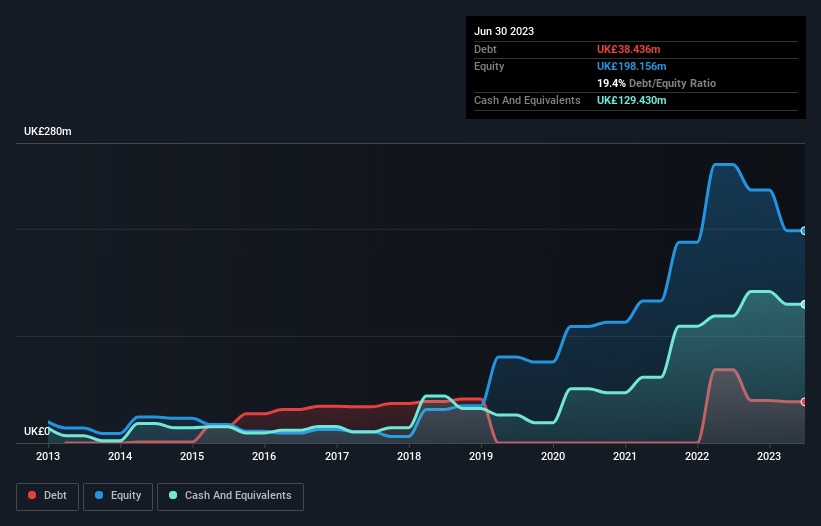
David Iben put it well when he said, 'Volatility is not a risk we care about. What we care about is avoiding the permanent loss of capital.' It's only natural to consider a company's balance sheet when you examine how risky it is, since debt is often involved when a business collapses. We note that Oxford Biomedica plc (LON:OXB) does have debt on its balance sheet. But is this debt a concern to shareholders?
What Risk Does Debt Bring?
Debt and other liabilities become risky for a business when it cannot easily fulfill those obligations, either with free cash flow or by raising capital at an attractive price. Ultimately, if the company can't fulfill its legal obligations to repay debt, shareholders could walk away with nothing. However, a more common (but still painful) scenario is that it has to raise new equity capital at a low price, thus permanently diluting shareholders. Of course, the upside of debt is that it often represents cheap capital, especially when it replaces dilution in a company with the ability to reinvest at high rates of return. The first thing to do when considering how much debt a business uses is to look at its cash and debt together.
View our latest analysis for Oxford Biomedica
How Much Debt Does Oxford Biomedica Carry?
As you can see below, Oxford Biomedica had UK£38.4m of debt at June 2023, down from UK£68.4m a year prior. However, its balance sheet shows it holds UK£129.4m in cash, so it actually has UK£91.0m net cash.

How Strong Is Oxford Biomedica's Balance Sheet?
The latest balance sheet data shows that Oxford Biomedica had liabilities of UK£53.5m due within a year, and liabilities of UK£149.4m falling due after that. Offsetting these obligations, it had cash of UK£129.4m as well as receivables valued at UK£29.5m due within 12 months. So its liabilities outweigh the sum of its cash and (near-term) receivables by UK£43.9m.
Of course, Oxford Biomedica has a market capitalization of UK£250.2m, so these liabilities are probably manageable. But there are sufficient liabilities that we would certainly recommend shareholders continue to monitor the balance sheet, going forward. Despite its noteworthy liabilities, Oxford Biomedica boasts net cash, so it's fair to say it does not have a heavy debt load! When analysing debt levels, the balance sheet is the obvious place to start. But it is future earnings, more than anything, that will determine Oxford Biomedica's ability to maintain a healthy balance sheet going forward. So if you want to see what the professionals think, you might find this free report on analyst profit forecasts to be interesting.
Over 12 months, Oxford Biomedica made a loss at the EBIT level, and saw its revenue drop to UK£119m, which is a fall of 5.2%. That's not what we would hope to see.
So How Risky Is Oxford Biomedica?
By their very nature companies that are losing money are more risky than those with a long history of profitability. And in the last year Oxford Biomedica had an earnings before interest and tax (EBIT) loss, truth be told. And over the same period it saw negative free cash outflow of UK£8.7m and booked a UK£62m accounting loss. Given it only has net cash of UK£91.0m, the company may need to raise more capital if it doesn't reach break-even soon. Summing up, we're a little skeptical of this one, as it seems fairly risky in the absence of free cashflow. The balance sheet is clearly the area to focus on when you are analysing debt. But ultimately, every company can contain risks that exist outside of the balance sheet. For instance, we've identified 1 warning sign for Oxford Biomedica that you should be aware of.
If, after all that, you're more interested in a fast growing company with a rock-solid balance sheet, then check out our list of net cash growth stocks without delay.
New: AI Stock Screener & Alerts
Our new AI Stock Screener scans the market every day to uncover opportunities.
• Dividend Powerhouses (3%+ Yield)
• Undervalued Small Caps with Insider Buying
• High growth Tech and AI Companies
Or build your own from over 50 metrics.
Have feedback on this article? Concerned about the content? Get in touch with us directly. Alternatively, email editorial-team (at) simplywallst.com.
This article by Simply Wall St is general in nature. We provide commentary based on historical data and analyst forecasts only using an unbiased methodology and our articles are not intended to be financial advice. It does not constitute a recommendation to buy or sell any stock, and does not take account of your objectives, or your financial situation. We aim to bring you long-term focused analysis driven by fundamental data. Note that our analysis may not factor in the latest price-sensitive company announcements or qualitative material. Simply Wall St has no position in any stocks mentioned.
About LSE:OXB
Oxford Biomedica
A contract development and manufacturing organization, focuses on delivering therapies to patients worldwide.
High growth potential and good value.
Similar Companies
Market Insights
Community Narratives



